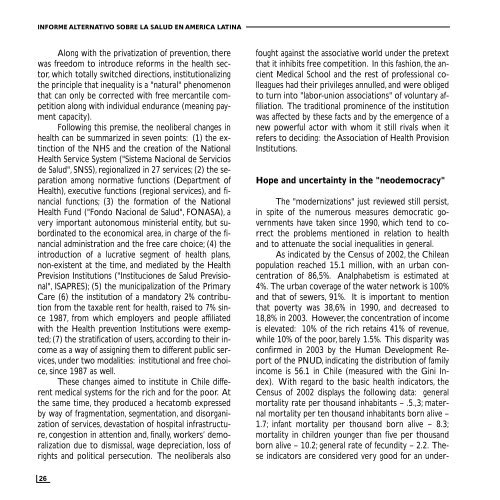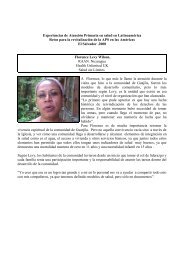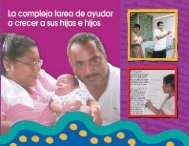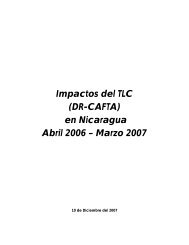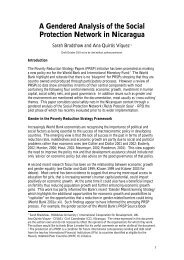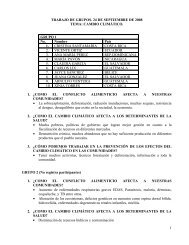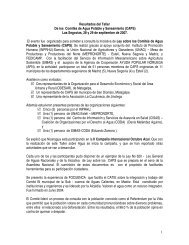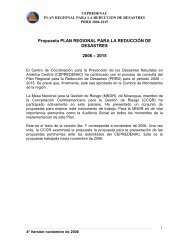Download - CISAS | Centro de Información y Servicios de AsesorÃa ...
Download - CISAS | Centro de Información y Servicios de AsesorÃa ...
Download - CISAS | Centro de Información y Servicios de AsesorÃa ...
Create successful ePaper yourself
Turn your PDF publications into a flip-book with our unique Google optimized e-Paper software.
INFORME ALTERNATIVO SOBRE LA SALUD EN AMERICA LATINAAlong with the privatization of prevention, therewas freedom to introduce reforms in the health sector,which totally switched directions, institutionalizingthe principle that inequality is a "natural" phenomenonthat can only be corrected with free mercantile competitionalong with individual endurance (meaning paymentcapacity).Following this premise, the neoliberal changes inhealth can be summarized in seven points: (1) the extinctionof the NHS and the creation of the NationalHealth Service System ("Sistema Nacional <strong>de</strong> <strong>Servicios</strong><strong>de</strong> Salud", SNSS), regionalized in 27 services; (2) the separationamong normative functions (Department ofHealth), executive functions (regional services), and financialfunctions; (3) the formation of the NationalHealth Fund ("Fondo Nacional <strong>de</strong> Salud", FONASA), avery important autonomous ministerial entity, but subordinatedto the economical area, in charge of the financialadministration and the free care choice; (4) theintroduction of a lucrative segment of health plans,non-existent at the time, and mediated by the HealthPrevision Institutions ("Instituciones <strong>de</strong> Salud Previsional",ISAPRES); (5) the municipalization of the PrimaryCare (6) the institution of a mandatory 2% contributionfrom the taxable rent for health, raised to 7% since1987, from which employers and people affiliatedwith the Health prevention Institutions were exempted;(7) the stratification of users, according to their incomeas a way of assigning them to different public services,un<strong>de</strong>r two modalities: institutional and free choice,since 1987 as well.These changes aimed to institute in Chile differentmedical systems for the rich and for the poor. Atthe same time, they produced a hecatomb expressedby way of fragmentation, segmentation, and disorganizationof services, <strong>de</strong>vastation of hospital infrastructure,congestion in attention and, finally, workers’ <strong>de</strong>moralizationdue to dismissal, wage <strong>de</strong>preciation, loss ofrights and political persecution. The neoliberals alsofought against the associative world un<strong>de</strong>r the pretextthat it inhibits free competition. In this fashion, the ancientMedical School and the rest of professional colleagueshad their privileges annulled, and were obligedto turn into "labor-union associations" of voluntary affiliation.The traditional prominence of the institutionwas affected by these facts and by the emergence of anew powerful actor with whom it still rivals when itrefers to <strong>de</strong>ciding: the Association of Health ProvisionInstitutions.Hope and uncertainty in the "neo<strong>de</strong>mocracy"The "mo<strong>de</strong>rnizations" just reviewed still persist,in spite of the numerous measures <strong>de</strong>mocratic governmentshave taken since 1990, which tend to correctthe problems mentioned in relation to healthand to attenuate the social inequalities in general.As indicated by the Census of 2002, the Chileanpopulation reached 15.1 million, with an urban concentrationof 86,5%. Analphabetism is estimated at4%. The urban coverage of the water network is 100%and that of sewers, 91%. It is important to mentionthat poverty was 38,6% in 1990, and <strong>de</strong>creased to18,8% in 2003. However, the concentration of incomeis elevated: 10% of the rich retains 41% of revenue,while 10% of the poor, barely 1.5%. This disparity wasconfirmed in 2003 by the Human Development Reportof the PNUD, indicating the distribution of familyincome is 56.1 in Chile (measured with the Gini In<strong>de</strong>x).With regard to the basic health indicators, theCensus of 2002 displays the following data: generalmortality rate per thousand inhabitants – .5.,3; maternalmortality per ten thousand inhabitants born alive –1.7; infant mortality per thousand born alive – 8.3;mortality in children younger than five per thousandborn alive – 10.2; general rate of fecundity – 2.2. Theseindicators are consi<strong>de</strong>red very good for an un<strong>de</strong>r-26


